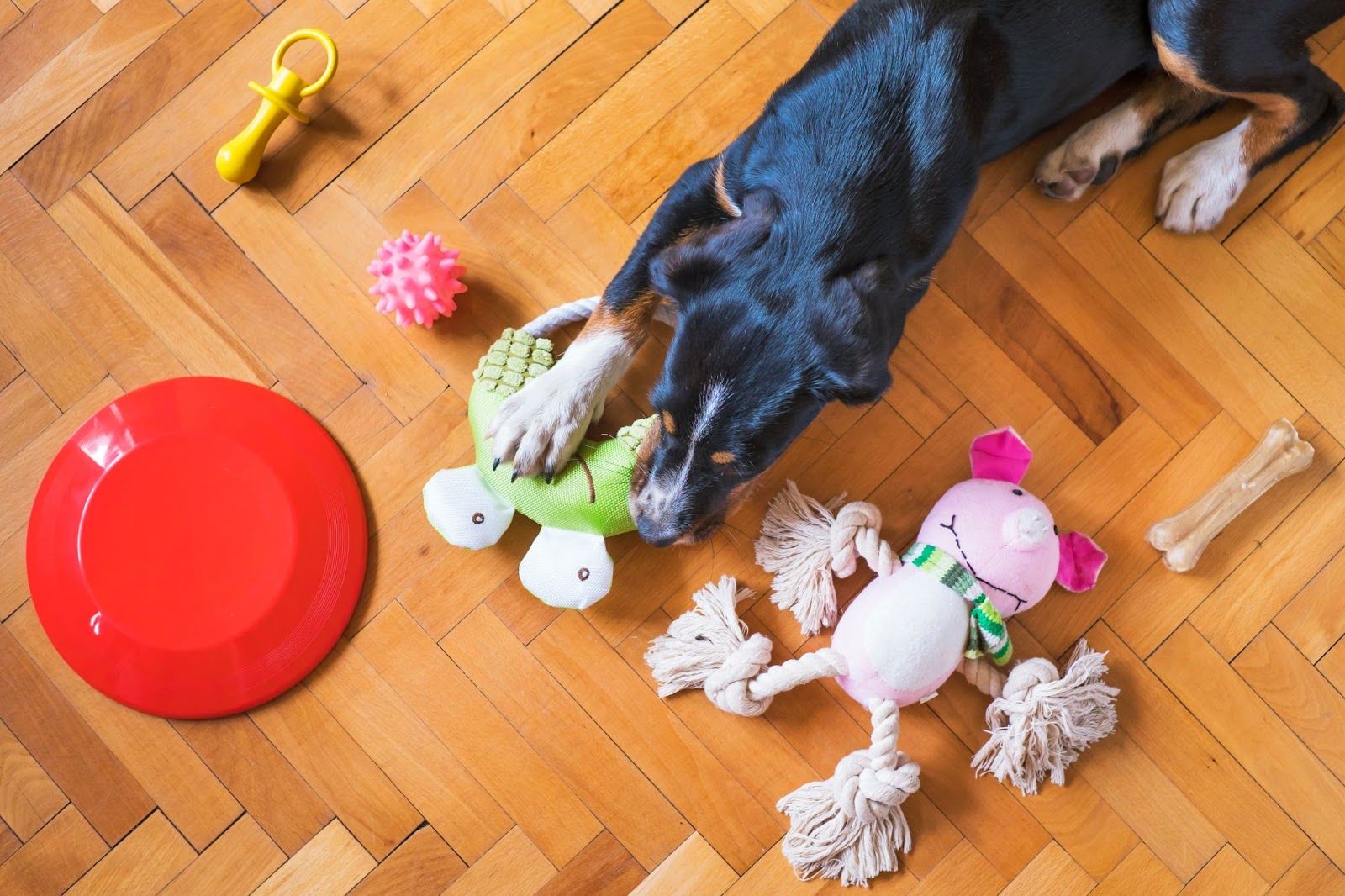Spring Cleaning is upon us, and your dog’s toys and supplies are no exception.

Pet-Friendly Spring Cleaning
When spring cleaning comes around, you often think about cleaning out the garage, or deep cleaning those little nooks and crannies around the house. But do you always remember to clean your dog’s toys and pet supplies? How dirty is that dog bed? Have you looked inside of their Kong peanut butter toy lately?
We’ve got some recommendations for you about what to clean, how to clean it, when to throw it away, and what cleaners are safe for pets. Remember—all cleaning products are not created equal. So check out the advice below before you start.

Pet-Safe Cleaning Products
You may not realize it, but there are chemicals in certain cleaning products that can be harmful to your pets. The American Kennel Club tells us that “According to the American Veterinary Medical Foundation, bleach, phenols, products with high chemical concentrations and some detergents can cause vomiting, diarrhea, and severe chemical burns.” And nobody wants that!
To avoid any harm to your little furball, try out companies like Mrs. Meyer’s and BlueLand. They provide safer cleaning options—and you won’t need to worry about harmful toxins. There are actually many companies you can find that make pet-safe cleaning products. One of my other favorites is Seventh Generation. They make cleaning supplies from plant-based formulas that are put into recycled packaging. They even make a laundry detergent that is safe to wash your pup’s toys in.

Another pet-safe cleaning alternative is using two simple products… baking soda & vinegar! Baking soda can be used as a general cleaner because of its more abrasive qualities, and a deodorizer for your carpets. You can even mix it with some water and a little salt for scrubbing. And vinegar has both anti-fungal and antibacterial properties. It can be diluted by 50% with water and used to remove soap scum or even as a degreaser.
How to Clean Your Dog’s Toys, Bedding, and Supplies
1. Stuffed Animals & Dog Beds
Let’s start with the soft stuff. As mentioned above, you can purchase pet-safe, plant-based laundry detergent. Just toss your dog’s stuffed animals, blankets, and pet bed in the washing machine, and they’ll be good as new! But remember that some pet beds may need to go on the “gentle cycle.” And some toys may need a little stitching before they get washed. Otherwise, you may end up with a washer full of stuffing.

2. Hard Material Toys & Supplies
If you have any nylon, plastic, or rubber toys, these can be washed by hand with some simple liquid dish soap and water. This also applies to any plastic, silicone, or metal dog bowls. Dawn dish soap is known for being gentle enough to wash animals. And Seventh Generation makes plant-based dish soap. Some people will even put these hard-material items in a dishwasher. But make sure each item is actually deemed “dishwasher safe” by the manufacturer.
3. Toy Ropes
Many people say that you can clean the bacteria off of a toy rope by microwaving it because of a study done about microwaving a dish sponge. However, a newer study shows that microwaving something like a sponge—or rope—does not actually remove all of the bacteria. If you do choose to try microwaving your dog’s toy rope, just keep a close eye on it. And remember that it may be best to just replace it once it has gotten too dirty.
When to Throw Away Dog Toys
As much as your pooch may love certain toys, there comes a time for every item when it needs to be discarded. Dogs aren’t the most gentle with their toys. In fact, half of the fun for them is getting to tear things apart. But that can create choking hazards, so let’s try our best to keep them safe.
Make sure to keep an eye on any toy that has been severely chewed up, especially if you notice pieces missing. Hopefully those pieces wind up on the floor—but some dogs will end up eating parts of a plastic, rubber, or cloth toy. And all of these can be harmful, if swallowed.

Also watch for any toy that has pieces hanging on by a thread, like the plastic eyes on a stuffed animal. Again, we don’t want the dogs choking on these or swallowing them. And if you have any concerns about this, make sure to contact your veterinarian immediately.
Make a List and Check it Twice
Now that you know some of the ways to keep your dog’s toys, bowls, and supplies clean and safe, try making a checklist for each year. In fact, it’s probably best to pull out this checklist once a quarter. That way you can feel at ease, knowing that your furry best friend is staying healthy because his toys and supplies are sanitary, and pet-safe.

